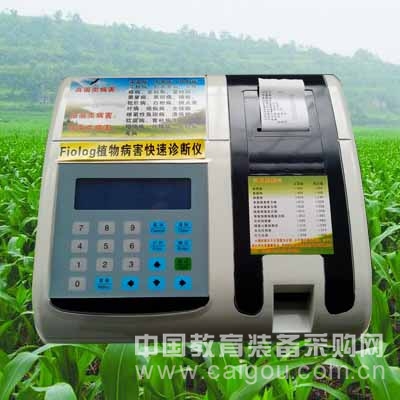I. Overview
Bacteria, fungi and viruses are the main causes of crop diseases. These diseased microorganisms generally infect plants through stems, leaves, roots, fruits, etc. Most of the diseases are easier to control in the early stage of infection, but they are generally not easy to be detected. Once the disease occurs, the prevention and control is not only difficult but also has poor effect, resulting in crop yield reduction. Even the best. How to detect and timely prevent and treat diseases in the early stage of disease is particularly important for the prevention and treatment of diseases.
The detection of plant diseases is a complex chemical and physical process. It has always been the goal of people to go from the laboratory to the practical application. The instrument can quickly analyze and determine the types of crop diseases. It provides a scientific and theoretical basis for how to prevent and cure diseases and drugs, and brings great convenience to farmers and farmers.
Second, technical indicators and working environment
1. Measurement principle: The principle of ultra-high brightness cold light source reflection measurement.
2. Test speed: 60 copies/hour for a single test and 120/hour for a continuous test.
3, recording method: thermal printer printing.
4, display mode: 240 * 60 dot matrix LCD display.
5. Recording paper: thermal printing paper, 57mm.
6, working environment:
(1) Working temperature: 0°-40°;
(2) Relative humidity: RH ≤ 85%;
(3) Keep away from strong electromagnetic field interference sources and avoid direct exposure to strong light.
7, working power: AC220V ± 10%, 50Hz ± 2Hz
8, power: ≤ 30W
9, net weight: ≤ 3kg
Third, the detection principle
According to biophysical methods: the membrane position of general healthy plants is about -50 mv, the transmembrane resistance of the outer liquid is about 105 Ω/cm, and the membrane capacitance is basically maintained at 1 uf. The instrument uses monochromatic light to scan the reaction zone on the test strip item by item. Because the reflectivity of the monochromatic light is different under different colors and colors, the gradient of the reflectance is determined to determine the plant. The content of various biochemical components in the juice. The monochromatic light of the instrument scans the test strip, and the scanning system converts the optical signal into an electrical signal.
Fourth, the instrument configuration
1. One host, two test strips, one box, one manual
4, the fuse 2 5, the power cord a 6, a warranty card
7, a roll of printing paper 8, a set of indicator liquid (5 bottles) 9, a certificate of conformity
Five, operating procedures
(1) Instrument installation
Connect the power cord normally, install the printing paper according to the method described below, turn on the power, the instrument will perform system self-test, the stage will be removed, and it will stop at the working position. The self-test is normal and the instrument can work normally. Press the START button to start the test.
(2) Installation of printing paper
1. Use a thermal paper roll with a width of 57mm.
2. Press down on the center of the printer and the printer cover latches up and remove the printer cover.
3. Put the new paper roll into the paper roll box and release the paper roll so that the paper end is close to the inside of the instrument.
4. Open the printer loading handle, insert the printing paper vertically into the printer, pull down the printing paper, and feel the movement freely to lower the handle. (The thermal printing paper is divided into front and back, please do not install it.)
5. Pass the paper through the paper exit of the printer cover and cover the cover.
(3) Starting the instrument
1. Turn on the power, the instrument starts self-test, and the detection slot moves out slowly, waiting for the test.
2. The roots, stems and leaves of the plant are cut and placed in a mortar, the number is about one-third to one-fifth of the volume of the mortar; ground with a grinding rod.
3. Draw an equal amount of 3-5 drops of five kinds of indicator liquids with a dropper, drip into the mortar containing the stems and leaves of the plants, stir evenly, and let stand for 2-3 minutes.
4. Rinse the dropper with clean water, then aspirate the mixture of indicator and plant debris a little, evenly spread on the indicator strip, and put the indicator strip into the test slot with the colored bars facing up.
5. Gently press the “Test†button. After the “beep†sound is heard, the tester starts to detect. The test slot and indicator bar are slowly moved to the instrument and then returned. At this time, the instrument automatically prints the test result. (Note: Press “↑†after the test, the stage is indented.)
Sixth, the result analysis normal value reference value
Viral disease ≥ 493 ≤ 262
Fungal disease ≥ 485 ≤ 266
Bacterial disease ≥420 ≤249
Fungal virus compound disease ≥ 472 ≤ 228
Fungal bacterial compound disease ≥ 502 ≤ 258
Viral bacterial compound disease ≥ 511 ≤ 316
Fungal bacterial virus compound disease ≥412 ≤147
Residual amount ≥ 096 ≤ 063
Trace element deficiency syndrome ≥372 ≤236
Photosynthesis rate ≥ 505 ≤ 311
Leaf growth ≥ 438 ≤ 402
★ The test value is between the normal value and the reference value. The crop is sub-healthy and can be referred to the medication.
Seven, medication guide
The test value is the reference value for guiding the drug. The less the test value indicates that the crop disease is more serious or the plant grows weaker. In addition to the use of the fungicide, the foliar fertilizer should be applied, and the dosage cannot exceed the limit value of a certain drug, otherwise the phytotoxicity may occur.
Eight, matters needing attention
1. Avoid testing in places where strong light is shining.
2, pay attention to electricity safety, air humidity should be stopped when it exceeds 85%.
3. The instrument should be stored in a ventilated, dry, dark place and covered with a dry cloth.
4. The test slot and printhead should be kept clean.
Nine, routine maintenance, maintenance and precautions for rapid diagnosis of plant diseases
1. Place the instrument on a water platform with horizontal, fixed, direct sunlight, and no strong electromagnetic field interference.
2. Wipe the instrument regularly with a clean, soft, dry cloth to keep the instrument clean.
3. The small cover of the printer should be placed on the printer to prevent liquid from entering the inside of the instrument.
4. The instrument should be retracted inside the instrument before the instrument is shut down every day.
5. If the test platform is dirty, remove the test platform, rinse the test platform with clean water, and then dry the upper groove with liquid-absorbent paper. Return to the original position and keep the stage in the instrument case to prevent external force from damaging the stage.
★Note: Do not soil, scratch or clean the round white part of the platform with chemical solvents when cleaning the test platform.
6. The test strips and residual sap after use shall be collected, stored and disposed of in accordance with relevant regulations.
7. Normally used instruments should be tested and verified correctly using quality control products and standards, and found to be calibrated in time.
8. The operator should be professionally trained and possess considerable professional knowledge and operational skills.
9. The instrument must be protected from strong impact, rain and exposure during handling.
10. The instrument should be stored in a room with a relative humidity of no more than 80%, no corrosive gas and good ventilation.
11. Please use the test strips of our company. Using test strips of different manufacturers or models may indicate that the measurement results are inaccurate.
X. Common faults and treatment of plant disease rapid diagnostic equipment
1. Fault phenomenon: no display on the screen
Remedy: Is the power switch turned on?
The fuse is broken and the fuse is replaced.
2, the phenomenon of failure: the printer does not print or has printing paper but no display on paper
Remedy: Check that the printer should be in the "built in" and "on" positions.
The printer has no paper, and the printer is loaded with paper.
3. Fault phenomenon: the test result is not accurate
Remedy: Deterioration of the test strip, replacement of the test strip
The test strip is shifted during the test and should be retested
The test strip is not in place and should be near the top of the test strip
The test strip is contaminated by residual juice on the stage, and the test platform should be cleaned.
Excess juice is left on the test strip, and the excess juice is absorbed by the absorbent paper and then re-measured.
XI, after-sales service matters
This product is issued three packs from the date of purchase, and the whole machine is guaranteed for one year. Any one of the following conditions will not be repaired.
1. If the user uses it improperly or the voltage exceeds 250V, it will cause damage.
2. The user is damaged due to improper transportation and storage.
3. The user can repair it without authorization and replace the parts to cause damage.
4. No warranty card and invoice.
5. The machine number filled in the warranty card does not match the repair machine number or is altered.
If you find any quality problems, please contact the purchasing unit or the after-sales service department of the company.

The ergonomic chair can be used by both children and adults. The height can be adjusted to protect the spine and allow children to develop good sitting habits from an early age. The latex cushion and knitted fabric are very breathable, so that the child will not get tired when studying; A chair that can accompany your child`s growth. You can use this chair during the learning time of 3-18 years old. 
New Design Kid Study Chair,Adjustable Height Study Chair,Ergonomic Student Chair,Kids Computer Desk Chair
SUZHOU IGROW TECHNOLOGY CO.,LTO , https://www.igrowdesk.com